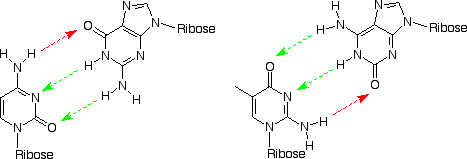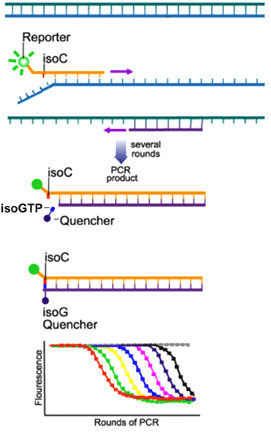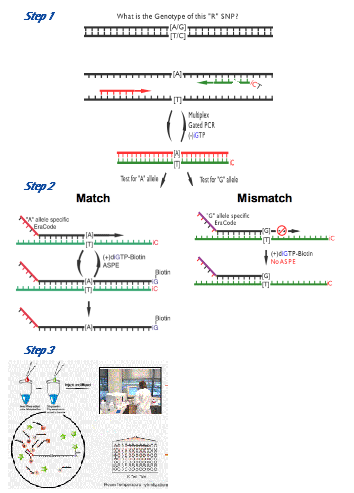Glen Report 16.22: EraGen BioSciences Technology (courtesy of EraGen Biosciences)
In natural DNA, two complementary strands are joined by a sequence of Watson-Crick base pairs. These obey two rules of complementarity: size (large purines pair with smaller pyrimidines) and hydrogen bonding (hydrogen bond donors from one nucleobase pair with hydrogen bond acceptors from the other). The former is necessary to permit the structure that underlies enzyme recognition. The latter achieves the specificity that gives rise to the simple rules for base pairing (“A pairs with T, G pairs with C”) that underlie genetics and molecular biology. No other class of natural products has reactivity that obeys such simple rules. Nor is it obvious how one designs a class of chemical substances that does so much so simply.
Some time ago, Professor Steven Benner noticed that the DNA alphabet need not be limited to the four standard nucleotides known in nature. Rather, twelve nucleobases forming six base pairs joined by mutually exclusive hydrogen bonding patterns might be possible within the geometry of the Watson-Crick base pair. EraGen has exclusively licensed this idea and the inventions to follow in order to build more robust recognition and analysis systems.
Today, EraGen technology consists of two additional bases (isoCytosine (iC) and isoGuanosine (iG) that form the third base pair, as shown in Figure 1. EraGen has spent years optimizing the production of all needed reagents to allow the technology to reach its full potential. EraGen technology is being used in both solution and solid phase detection as described below.

Schematic of the natural pair Cytosine (C) and Guanosine (G) next to the EraGen pair isoCytosine (iC) and isoGuanosine (iG). Note the directionality of hydrogen bonding (depicted by arrows) is different between the two pairs.
| G | C | A | T | iG | iC | |
| C | 58 | 46 | 49 | 44 | 54 | 44 |
| G | 47 | 58 | 48 | 46 | 52 | 44 |
| T | 49 | 44 | 56 | 45 | 53 | 41 |
| A | 47 | 45 | 43 | 53 | 46 | 43 |
| iC | 45 | 44 | 42 | 41 | 62 | 44 |
| iG | 51 | 53 | 48 | 51 | 48 | 58 |
| 5'-CACPACTTTCTCCT-3' | ||||||
| 3'-GTGQTGAAAGAGGA-5' | ||||||
| P= column,Q= row | ||||||
Thermal melting points for 14-mer with single substitution of nucleotide at P (column) and Q (row) position. Correct match is shown on the diagonal in Red and underlined.
Details
Research has shown that the complementarity rules for EraGen technology are analogous to those of natural DNA. Therefore, any researcher can exploit the rule-based molecular recognition properties to design molecules built from EraGen components that will bind to other molecules built from the corresponding binding partner.
Since the recognition is specific, EraGen provides a molecular recognition system that is “orthogonal” to that provided by natural DNA. The table shown in Figure 2 is constructed so that the Tm value for duplexes obeying the extended Watson-Crick pairing rules are found along the diagonal (values are underlined). In each case, the underlined value is higher than any of the Tm values associated with the mismatches. Especially important is the observation that the Tm values for mismatches with standard nucleobases are lower than the Tm values for mismatches with the correct EraGen component.
State-Of-The-Art Products
EraGen is providing scientific professionals with new options to address their research and molecular diagnostic needs. Under license from EraGen, Bayer Diagnostics has incorporated EraGen Technology into their third generation branched DNA assays (Versant™) to achieve previously unattainable levels of sensitivity and specificity for quantitative viral load testing in clinical labs.
EraGen is currently commercializing two platforms with optimized reagent sets: GENE-CODE®, a real time PCR alternative to Taq-Man® and SYBR Green; and MULTI-CODE®, a multiplexed genotyping analysis system. The platform technologies utilize the iC and iG amidites and newly developed triphosphates to capture assay products and incorporate signaling molecules.
Figure 3 shows how these advanced reagents are used to perform Gene-Code. Overall, the advantages of the Gene-Code real-time PCR system are as follows:
- Implemented with any current primer designs
- High sensitivity and specificity
- Multiplex capability
- Implemented on most real time instrumention
- Excellent reproducibility
- Post PCR thermal melt – Control for correct amplified sequence
- Long shelf life

Gene-Code assay system with a single labeled primer containing an iC with a natural reverse primer. During PCR amplification, iGTP-quencher is specifically incorporated opposite the iC, causing a dramatic and rapid decrease in fluorescence as shown in the bottom panel. Multiplexing is achieved by the use of multiple dyes that do not spectrally overlap.

The three steps of the Multi-Code system are shown below. Step one is standard multiplexed PCR using a primer with an iC at the 5’ end in the absence of iG-biotin, which results in a “gated” amplicon. Primer extenders and iG-biotin are added for the allelic-specific primer extension step, which results in extended primers with a label and specific capture code. In the third and final step, SAPE and Luminex microparticles are added just prior to injection onto the Luminex instrument. Data analysis is performed on EraGen’s proprietary software.
The unique characteristics of EraGen technology were also used to develop Multi-Code, a high throughput genotyping system (Figure 4). Overall, the advantages of the Multi-Code multiplexing platform are as follows:
- Flexibility
- No washing, no centrifugation, no filtration
- High sensitivity and specificity
- High multiplexing capability
- Implemented on Luminex instrumentation
Employing EraGen technology in this fashion allows all Multi-Code assays to be performed in a single reaction vessel requiring less plastic and allowing for easier automation.
Summary
The EraGen Technology is being implemented in some of the most impressive new platforms to hit the market recently. This new paradigm shift in fundamental biology will allow scientists to greatly simplify genetic analysis. With these new reagents and their improved characteristics, EraGen Biosciences is proud to be working with Glen Research to provide today’s researcher with exciting new alternatives in molecular diagnostics and genetic analysis tools.
For more information please visit or reference recent publications:
Nucleic Acids Research, 2003, 31(17), 5048-5053, and Clinical Chemistry, 2003, 49(3), 407-414.
Note: Oligos containing 5-Me-iso-dC should be stored buffered at pH 7.5 to 8.0 to avoid decomposition.
Product Information
Dithiol Phosphoramidite (DTPA) has been discontinued
- Glen Report 16.21: Thymine dimers - DNA Lesions Induced By Sunlight CIS-SYN Thymine Dimer Phosphoramidite Now Available
- Glen Report 16.22: EraGen BioSciences Technology (courtesy of EraGen Biosciences)
- Glen Report 16.23: Activators, Columns and Plates
- Glen Report 16.24: Locked Nucleic Acid (LNA™) Phosphoramidites
- Glen Report 16.25: Trimer (Codon) Phosphoramidites Simplify Library Preparation
- Glen Report 16.26: Still More New Products
- Glen Report 16.27: New Epoch Products - 5'-Aldehyde-Modifier C2 Phosphoramidite and Gig Harbor Green™ Phosphoramidite

